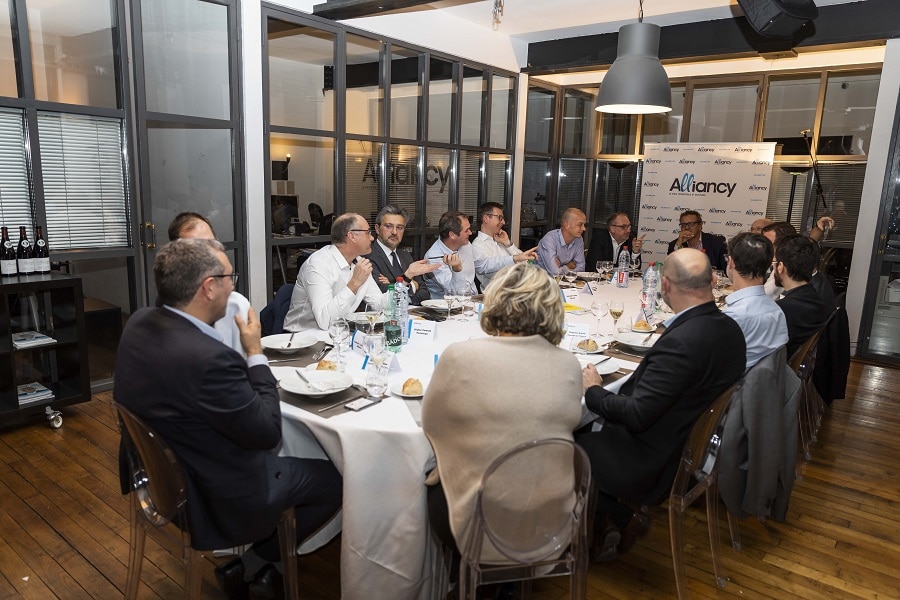Lucernys was the initiator of the dinner-debate “CIOs in the multi-cloud era: how to control complexity (and costs)” organized by Alliancy, a media of influence on business transformation. In just a few years, the Cloud has become a major gas pedal of business transformation. However, pay-per-use, the keystone of the model, implies a change of culture for the IT department and managing the cloud from an operational and financial point of view has become a challenge in its own right. In this “new era” where information systems have become hybrid and are based on multi-cloud, many IT departments have taken matters into their own hands. What makes it possible to take full advantage of these new Cloud approaches? Which “multi-cloud” practices have really proven themselves? Where are the skills? Find below the opinion of some participants.
Interview by Alliancy / Photos : Guillaume Ombreux
Already at the heart of the concerns of the Alliancy editorial team when it was created 6 years ago, the Cloud seemed, according to Sylvain Fievet, Alliancy’s Publishing Director, to augur a certain complexity in the choices to be made. “would necessarily be faced by companies, beyond the seductive promises of the model”. According to him, in 6 years, the maturity of organizations has deeply evolved, but the complexity persists. Today new questions arise,” he explains, “nparticularly around the key competencies that will enable us to really seize the flexibility of the cloud. No CIO today believes that these gains will be achieved without real commitment and preparation on their part.”.

Round table in partnership with Alliancy on the theme: CIOs in the multi-cloud era, how to control complexity (and costs)?
Stéphane Rousseau, director of information systems at Eiffage, agrees, even though he says, “You have to be realistic, if we are being sold more and more clouds, it’s also because from the provider’s point of view, the economic equation is very interesting. For him, great vigilance is therefore required: the CIO must not give in to the sirens of fashion and each transformation must be well calculated. For all that, according to him, all companies today are mechanically in multicloud. Let’s be humble,” he explains, we all still need to learn, as we know that the financial stakes will increase. Already on a single cloud, these issues are complex, as the cost structures themselves are difficult to grasp.”. For Stéphane Rousseau, this complexity increases exponentially with the number of clouds. There is therefore an urgent need to develop new functions in the IT department that will be at the crossroads between IT and management control.
The CIO is not averse to financial thinking!
Thierry Adenis, Director of Information Systems, believes that “there is still a need to educate the Executive Committee about these issues, because they often do not see the difference between a single use of a public cloud and a complete or partial rethinking of their information system based on the cloud. According to him, the CIO cannot carry this responsibility alone, as the transformation is both cultural and technical for the company, both with the CIO employees and the business departments. “When we worry about cost control of the cloud and multi-cloud, he believes, we realize that we have often never taken the necessary steps to engage the operational and technical actors of the IT department on these issues. Let’s not assume that they are hostile to all financial thinking, quite the contrary!”

Christophe Boulaire, Director of Information Systems at Sagemcom
For his part, Christophe Boulaire, Director of Information Systems at Sagemcom, believes that his business is subject to multiple new constraints, especially as an industrial player involved in the manufacture of products such as Linky meters and other IoT innovations. “When I look at the cloud,” he explains, ” my challenge is to find the right balance between extremely important security issues, a real need for agility in my organization, and a strong concern about controlling the costs that these operating changes can induce, sometimes in an opaque way. According to him, the first financial manager of IT is the CIO, who must ensure that – cloud or not – any project is profitable. “The priority today is to spread this mindset throughout the teams, including the business side, innovation, R&D, so that we can really take advantage of the interests of the cloud, which for me are first and foremost around agility.”
We need to find the right levers for performance but also for savings
The same is true for AXA Investment Managers, through its Deputy CTO Eric Bercovici, who believes that the difficulties in controlling complexity and costs are not only related to multi-cloud: “there is already a lot to do on a single cloud! At AXA IM, we have just built the foundations that will allow us to structure our migration to the cloud. Before we make that commitment, we will very clearly put in place new cost control mechanisms, so that we can keep control.”. In particular, the insurer has put in place a real practice of transparency between the comparative costs of cloud and on-premise, in order to look pragmatically at the implications of each of its choices and make them understood, in a desire for hybrid cloud. “This remains 100% compatible with our adoption of agile and DevOps approaches at all levels,” he concludes.

Eric Bercovici, Deputy CTO AXA Investment Managers
Against the backdrop of the merger with Malakoff-Médéric, Daniel Keller, Director of Transformation at Humanis, believes that the concentration of these activities had served to highlight a number of issues for the information system. When Humanis was created in 2013, the team in place had managed to achieve this synthesis during the merger of multiple IS players in the social protection sector. In 2019, it is a new adventure that seems to begin for the company, with an absolute necessity to find the right levers not only on performance but also on savings. “We keep a very close eye on how we approach the cloud,” says Daniel Keller, but it is clear that we will activate this lever while our IT department must massively evolve its businesses and support the structuring of coherent and value-creating data strategies within the company’s other businesses.”
In 2 years we have reversed the ratio between our operating costs and our investments
In the Penelope group, which specializes in corporate hospitality, the IT department has already switched many assets to the cloud. Including legacy, which is often considered a source of concern in terms of IS complexity but also in terms of cost control during cloudification. “It’s clearly this strategy that has allowed us to once again become an actor in the transformation of the company’s services, rather than the IT department being stuck in a simple role of day-to-day managementexplains Didier PawlakDirector of Information Systems at Penelope which recognizes, however, that there are not enough of them to completely dedicate skills to the financial management of the cloud. “Everyone in the IT department must therefore be mobilized on the subject,” he concludes.
In the Val d’Oise department, the IT department has also undergone significant changes in just a few years. So much so that for Olivier Lafosse, Director of Information Systems for the Val d’Oise, the budgetary approach may have surprised more than one player: “In two years we have reversed the ratio between our operating costs and our investments,” he explains. These now account for 54% of the ISD budget, up from just 18% in 2016. Today, we are all forced to innovate, to reinvent ourselves. We must be ready to question ourselves“. Whether it is about “opex” vs. “capex” or cost center vs. value and innovation center, the company wants to avoid any dogmatism and be proactive. “In 2019 we are embarking on a strategy of transformation towards the multicloud and hybridization of our IS to cope with the transformation of our vendors’ solutions that are switching to a service model (SAAS),” explains Olivier Lafosse. After last year’s adoption of Microsoft 365 for our office automation and device management, pragmatism prevails and we need to develop mastery in the clouds to support the shift to an agile and innovative public service.”
Be agile and practice efficient “stop and go” on the services consumed.
For Thierry Saive, Group IT Operation Services Director at Europcar, it is also the company’s transformation that is driving the thinking: “Europcar is no longer a car rental company,” he explains. For the past three years, we have been working to become the leading company in terms of mobility, regardless of the mode of transportation chosen by the user. This transformation requires a great deal of control over our information system.”. According to him, the cloud is not an obstacle in this respect, provided that we prepare very seriously for it, which involves a number of aspects, including the ability to be agile and to practice efficient “stop and go” on the services consumed. “We also need to strongly evolve the role of the IT asset manager,” he continues. The latter must become capable of managing financial assets, much more fluidly, echoing the nature of the cloud – what some call a FinOps approach.”

Catherine Croizier de Lacvivier, Director of Digital Transformation and Information Systems at Agrial Branche Agricole
The agricultural cooperative Agrial, also present at this round table, also raised the complexity of managing an IT system covering a very broad spectrum. At Agrial, extremely old elements coexist with a modern infrastructure capable of supporting a Datalake fed by IoT and satellite data. The company is therefore looking to move as much of its information system as possible to the Azure cloud, an operation which is not without significant budgetary implications and which forces the IT department to proceed in stages.
“I think the main challenge for an IT department is the one related to the culture of the teams and a brand new urbanization of the information system,” explains Catherine Croizier de Lacvivier, Director of Digital Transformation and Information Systems at Agrial Branche Agricole. In terms of cloud mastery, my priority is to increase the skills of Service Level Agreement Managers, who will be able to finely integrate the management of multiple cloud providers in the future.”
IT organizations often lack the financial culture that should be a key success factor
The same heterogeneity of the IS – and the same conclusions – within the IT ofAdenes, which for several years has made a significant transition to SaaS while having to deal with a significant heritage of “internal applications”. A situation that has raised many questions for the IT department in the context of a generalization of the cloud within the information system: “We have a strong concern about the question of costs that will be linked to this transformation, recognizes Aymeric Lacroix, Director of Information Systems of the group. Ideally, we need to strengthen our IT architects, SLA managers and buyers, to put in place a culture that will enable us to rethink our information system while better managing the financial challenges of this transformation. So the company intends to take a step-by-step approach and, in 2019, renew its legacy by watching very closely where the real gains are in the cloud.

Christophe Huerre, Director of Information Systems, Thalès Group
Christophe Huerre, Director of Information Systems at Thales Group, shares the same view of complexity: “For the past year, my mission has been to transform the IT of a complex group, half of whose business is related to the defense sector,” he explains. As a result, extreme caution should be exercised with regard to certain uses of the cloud. In parallel, the use of the cloud for “civil” activity, on AWS or Microsoft technologies, implies a duality of infrastructures and a segregation of uses generating an additional complexity”.. On the scale of a group like Thales, the cost of the cloud is obviously not neutral, but according to its CIO, it offers additional leverage for flexibility and cost optimization. “However, IT organizations often lack the financial culture that should be a key success factor for executing the technology vision,” he continues. It is the responsibility of the CIO to lead by example and to take on this financial responsibility. To optimize in the cloud era, it’s simply mandatory.”
To realize the promise of the cloud, you have to master it by the second, and that can’t be improvised
On a completely different note, Hervé Dumasgroup CTO of Veolia believes that with all of the cloud capabilities of SaaS, PaaS, IaaS, enterprise computing can truly enter an industrial logic that makes the most of today’s technologies by being faster, more flexible, more reliable, more secure and more environmentally friendly. “A virtuous dynamic of execution and innovation is taking place,” he explains, ” and the company is accompanying the evolution of skills and teams are spending more effective time addressing the technical and digital debt present in most organizations.

Bernard Schmitt, President of Lucernys
In conclusion, Bernard Schmitt, President of Lucernys, who initiated this dinner-debate with Alliancy, pointed out the classic error of seeing the IT department as a cost center for a long time: “Many IT departments are now capable of refocusing the debate on value creation,” he explains. However, when you want to use the power of the cloud to deliver on this promise, you need to be able to master it by the second, and that can’t be improvised. The people in the IT department who are best able to do this are indeed the operational staff, who are passionate about these technologies. However, including the financial side – in the form of a FinOps approach – at their level, is a huge transformation, to be anticipated.”. Christophe Dorin, Lucernys’ Sales and Marketing Director, supports this statement, stressing that “we are fortunate to be in a disruptive business, which is fully involved in the transformation of CIOs today and, in so doing, allows us to redefine in depth the role and leadership that a CIO can assume”.







